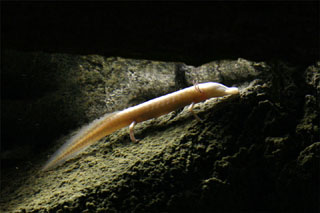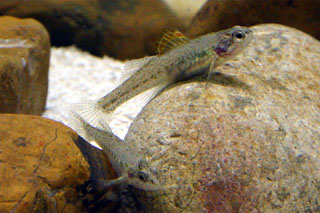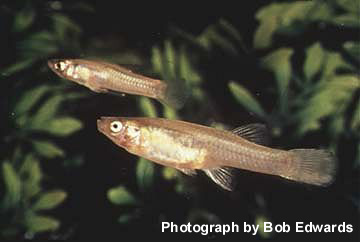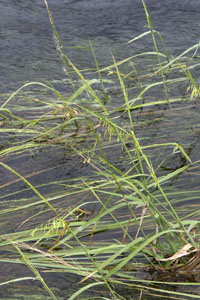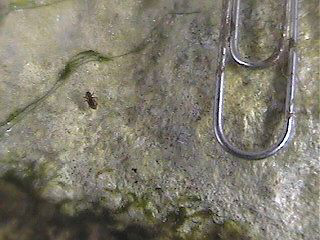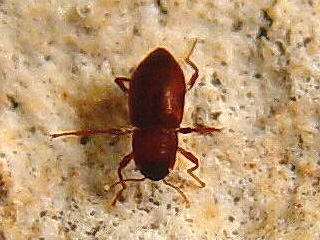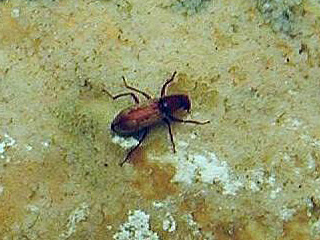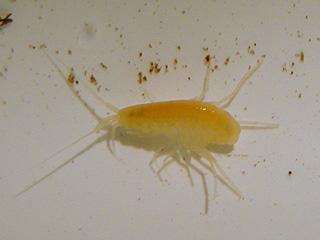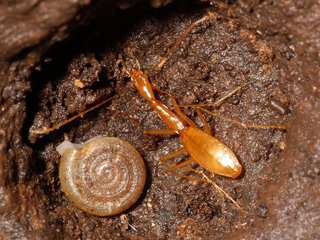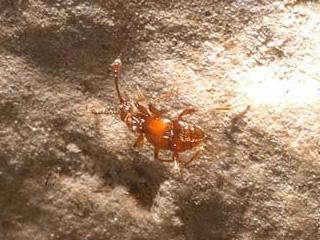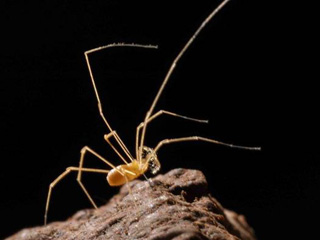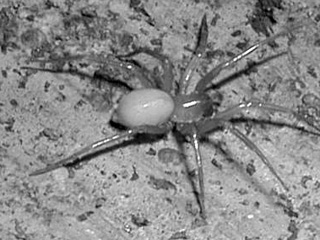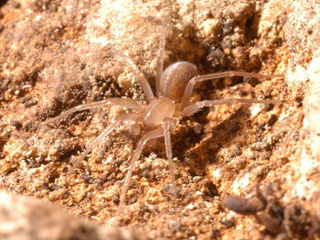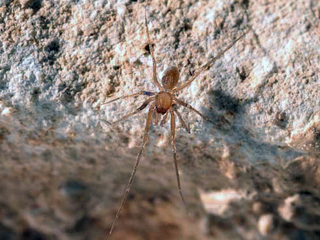
|
|
Endangered Species of the Edwards Aquifer Aquatic
species The World Wildlife Fund has produced a must-have, authoritative reference work for anyone interested in endangered species. It describes 540 endangered or threatened species, including their habitat, behavior, and recovery. Excerpts from their Guide to Endangered Species and other sources were used to prepare this section. Information on the aquatic invertebrates was prepared using the US Fish and Wildlife's published final rule on listing the species. The seven endangered species of the Edwards Aquifer system are:
The threatened species is: San Marcos Salamander (Eurycea nana) In addition to the aquatic species that depend on Aquifer water itself, nine cave-dwelling invertebrates that live in the Aquifer's karst formations were listed by the US Fish & Wildlife Service as endangered in December 2000. There are three beetles, one daddy long-legs, and five spiders. In May of 2008 the Service released a Draft Recovery Plan (download it). For a general discussion on all these creatures see the section below on the cave-dwelling invertebrates.
|
|||
|
Texas Blind Salamander (Typhlomolge rathbuni)
Description: The Texas blind salamander is a sightless, cave-dwelling salamander that reaches a mature length of about 13 centimeters (5 inches). It is a slender, frail-legged amphibian, white or pinkish in color with a fringe of blood-red, external gills. The head and snout are flattened. Two small black eyespots mark the location of vestigial eyes. Behavior: This totally aquatic species feeds on insects and other small invertebrates that live in subterranean waters and are nourished by the droppings of bats in caves. Little else of its natural history is known. Reproduction: Little is known, but gravid females have been observed throughout the year. The larvae do not transform. Habitat/Historic Range: The Texas blind salamander is endemic to the underground water system of the limestone caverns of the Edwards plateau. It spends its life in complete darkness. It is sensitive to changes of water quality and thus susceptible to groundwater pollutants. Current Distribution: Biologists know of only one population of the Texas blind salamander, which occurs in the Edwards Aquifer around San Marcos. The current population is apparently stable, although of limited numbers. It is possible that other populations may exist in unexplored underground caverns. Conservation and Recovery: Survival of this salamander depends upon the stability and continued purity of the Edwards Aquifer springflows. As with the other endangered species in the Edwards region, threats are from diminished springflows and pollution of groundwater and runoff caused by increasing demand for water and burgeoning development over recharge areas. |
|||
|
Fountain Darter (Etheostoma fonticola)
Description: The fountain darter is a reddish brown darter with an average length of 2.5 centimeters (1 inch). It displays a series of dark, horizontal, stitch-like lines along its sides and three dark spots at the base of the tail. Dark bars appear below, behind, and in front of the eyes. Breeding males develop black, red, and clear stripes along the dorsal fin. Behavior: The fountain darter feeds primarily in daylight on aquatic insect larvae and small crustaceans. It is a selective feeder and prefers moving prey, remaining stationary until prey passes within striking distance. The fountain darter spawns year round, with peaks in early spring and August. After attaching eggs to mosses and algae, the female abandons the site, providing no care to eggs or fry. Habitat: The fountain darter prefers clear, quiet backwaters with a profuse bottom growth of aquatic plants and matted algae. It is found in the San Marcos and Comal rivers. Historic Range: The historic range of the fountain darter included the sources, headwaters, and sections of the San Marcos and Comal rivers. Current Distribution: The fountain darter is found in Spring Lake at the headwaters of the San Marcos River, in the main channel of the river to the confluence of the Blanco River, and in the Comal River. The Comal River population of fountain darters was completely eliminated when its habitat was reduced to isolated pools by a major drought in the 1950's, but the river was restocked with 457 darters taken from the San Marcos River (USFWS, 1984). Schenck and Whiteside (1976) estimated the population in the San Marcos River between Spring Lake Dam and the San Marcos Wastewater Treatment Plant outfall to be 102,966 individuals. Until recently, no population estimates had been made for the Comal River. Linam, Mayes, and Saunders (1993) conducted a study to determine habitat utilization, the amount of habitat available, and an estimate of population size. Fountain darters were found in greatest densities in filamentous algae, and the mean population estimate for the Comal River upstream of Torrey Mill Dam was 168,078 with 95% confidence limits of 114,178 and 254,110. Conservation and Recovery: Actions that threaten the fountain darter include the destruction of aquatic vegetation in Spring Lake and the San Marcos River, recreational use of the San Marcos River, and long-term water depletion from the Edwards Aquifer. Swimmers and divers disturb the algae mats used by the darter for spawning. As with the San Marcos gambusia, recovery is considered a remote possibility without the cooperation of all state and local agencies that manage use of the Aquifer. Linam, Mayes, and Saunders (1993) concluded that despite the successful reintroduction effort after the 1950's drought, other factors might preclude it being replicated if the Springs should cease to flow again. Back then, enduring pools of water sustained some segments of the aquatic community, providing a base for reestablishment. However, the assumption that enduring pools will once again provide a remnant habitat for aquatic plants may no longer be valid. Since the introduction of giant rams-horn snails (Marisa cornuarietis) around 1983, plants in many areas of Landa Lake have been denuded of leaves or even grazed to the bottom (Horne, et al., 1992). These snails thrive in low flow conditions, and during a drought grazing could eliminate the fountain darter habitat. In a repeat of the 1950's drought, the Springs are also likely to be dry for a much longer period of time, and there may be changes in water quality that could limit another successful reintroduction. |
|||
|
San Marcos Gambusia (Gambusia georgei)
Description: The San Marcos Gambusia ranged in length from 2.5 to 4 centimeters (1 to 1.6 inches), had lemon yellow median fins and a diffuse midlateral stripe along the length of its body. The dark body displayed a bluish sheen, and scales tended to be strongly cross-hatched. Behavior: This fish was a livebearer - eggs hatched inside the female's body and emerge alive. The female was capable of bearing up to 60 young in a single brood. It fed on insect larvae and other invertebrates in slow-moving waters shaded by overhanging trees or bridges. Habitat: The San Marcos gambusia preferred quiet backwaters, adjacent to the main thrust of the river current. Its primary habitat requirements appeared to be clean and clear water of a constant temperature. Temperatures in the river vary by only a few degrees throughout the year, averaging about 23 degrees C (73 F). The bottom is muddy but generally unsilted. This species was restricted to a limited portion of the San Marcos River springrun a few kilometers below the headsprings. It was always rare. Historic Range: The gambusia's entire known range was
restricted to a 1-kilometer (0.6 miles) section of the San Marcos
River near the city of San Marcos. Most specimens were found
between the Interstate Highway 35 crossing and Thompson's Island. This gambusia was always extremely rare as determined by surveys
conducted in 1978 and 1979 in the San Marcos River. Biologists
netted more than 20,000 Gambusia specimens but counted only 18
San Marcos gambusia among them. Conservation and Recovery: The species' very restricted known distribution in the River and its absence from the headwaters at Spring Lake indicate very specific habitat requirements. It was apparently extremely sensitive to any alteration of its habitat. Changes in water turbidity caused by runoff from land clearing and construction, an increase in water temperatures caused by lowered water flows, and pumping of groundwater from the Edwards Aquifer could have easily eliminated the species. Even if additional specimens had been found, recovery of the San Marcos gambusia was considered a remote possibility. |
|||
|
San Marcos Salamander (Eurycea nana)
Photograph by Joe N. Fries Description: The slender-bodied San Marcos salamander is about 6 centimeters (2.4 inches) long and displays a prominent gill fringe behind the head. It is light brown above with a row of pale flecks on either side of the midline and yellowish white below. The large eyes have a dark ring around the lens. Limbs are short and slender with four toes on the forefeet and five on the hind feet. At first glance, it is similar to a lizard but lacks scales and claws. The specific name nana is from the Greek nanos, meaning "dwarf." This voiceless salamander is also earless. It was listed as endangered on July 14, 1980. Behavior: Salamanders lay jelly-covered eggs from which tiny fishlike larvae emerge and develop in the manner of tadpoles. The San Marcos salamander breeds and lays eggs in standing pools amid thick mats of aquatic vegetation. Eggs hatch in about 24 days. This species is carnivorous and feeds on amphipods, midge fly larvae, and aquatic snails. It remains stationary until prey pass closely and then abruptly snaps its head, taking the prey. Habitat: The San Marcos salamander is found in shallow alkaline springs carved out of limestone with sand and gravel substrates. Pools and streambeds are often punctuated with large limestone boulders. Aquatic vegetation is profuse, and the pool surfaces are covered with moss (Amblystegium riparium) and thick mats of coarse, blue-green algae. Historic Range: The species appears to be endemic to the sources and upper portions of the San Marcos River. Current Distribution: The limited range of the San Marcos salamander comprises the San Marcos Springs, Spring Lake, and a few hundred feet of the San Marcos River. The most recent estimates of population size indicate there are probably around 50,000 individuals. Tupa and Davis (1976) estimated there about 23,000 in algal mats, and Nelson (1993) estimated about 25,000 in rocks in Spring Lake and about 5,200 below the Lake. Conservation and Recovery: Although the population appears relatively stable for the moment, the salamander is threatened by potential degradation or modification of its very limited habitat. Increasing residential and agricultural development along with rising demand for water for human and agricultural uses may cause the spring sources become dry intermittently. The key to preserving the San Marcos salamander is controlling the amount of water pumped out of the Edwards Aquifer. |
|||
|
Texas Wild Rice (Zizania texana) Description: Texas wildrice is an aquatic grass with
thin, flat, elongated leaves that are typically immersed and
long-streaming in river currents. Leaves often grow as long as
1.5 meters (57 inches). Flower stalks, when present, extend above
the surface of the water, sometimes to a height of 1 meter (40
inches), and produce drooping heads of profuse grain-like seeds. The plant flowers and sets seed at irregular intervals from April
to November. Seeding plants have become increasingly rare in the
wild. It was listed as federally endangered on April 26, 1978 and
state endangered on April 29, 1983. It was the first Texas plant to be placed on the endangered species list. Habitat: Texas wildrice forms large clones or masses of clones that firmly root in gravel shallows near the middle of the river. This plant is adapted to fast-flowing water of high quality and constant year-round temperatures as provided by adequate spring flows. Silting, disturbance of the bottom, or stagnant water will kill off plants. Historic Range: This wildrice was once abundant in the San Marcos River, in contiguous irrigation ditches with constant flows, and in Spring Lake at the River's headwaters. In the 1930's it was so abundant that a local irrigation company considered it a difficult task to keep plants from clogging its ditches. Current Distribution: Texas wildrice is currently distributed along the upper four miles of the River in and near the city of San Marcos. In August of 2011, the Texas Parks and Wildlife Department proposed designating this stretch of the River a State Scientific Area, which is allowable under state law for the purposes of education, research, and preservation of plant and animal life. Conservation and Recovery: The major reason for decline of the San
Marcos River habitat has been increased pumping and diversion of
Edwards Aquifer groundwater. Decreased spring outflow lowers the
water level of the River and exposes the shallows where Texas
wildrice typically would grow. River dredging and damming, riverside construction, and
bottomland cultivation have destroyed plants, altered stream
flows and temperature, or increased siltation. In the past,
intensive harvesting of the seed crop inhibited successful
reproduction. |
|||
|
Comal Springs Riffle Beetle (Heterelmis comalensis)
Photographs by Joe N. Fries Description: The Comal Springs riffle beetle is a small aquatic, surface-dwelling species in the family Elmidae. Adult Comal Springs riffle beetles are about 1/8 inch long, with females slightly larger than males. The closest relative of H. comalensis appears to be H. glabra, a species that occurs farther to the west in the Big Bend region (Bosse, et al., 1988). Some riffle beetle species can fly (Brown, 1987), but the hind wings of H. comalensis are short and almost certainly non-functional, making the species incapable of this mode of dispersal (Bosse, et al., 1988). Habitat: Unlike the other two aquatic invertebrate organisms listed here, the Comal Springs riffle beetle is not a subterranean species. It occurs in the gravel substrate and shallow riffles in spring runs. Larvae have been collected with adults in the gravel substrate of the Spring headwaters and not on submerged wood as is typical of most Heterelmis species (Brown & Barr, 1988). Usual water depth in occupied habitat is 2 to 10 centimeters (1 to 4 in) although the beetle may also occur in slightly deeper areas within the Spring runs. Populations have been reported to reach their greatest densities from February to April (Bosse, et al., 1988). The Comal Springs riffle beetle has been collected from Spring runs 1, 2, and 3 at Comal Springs in Landa Park (springs j, k, and l in Brune, 1981) and a single specimen was collected from San Marcos Springs 32 km (20 mi) to the northeast. Historic Range: It was first collected by Bosse in 1976 and was described by Bosse, et al., in 1988. Nothing is known about whether this species may have historically ranged in other springs that are now dry almost all the time, such as San Pedro Springs and San Antonio Springs. Current Distribution: The Comal Springs riffle beetle is known from Comal Springs and San Marcos Springs. Conservation and Recovery: Because conservation and recovery of the three listed aquatic invertebrate species are very similar, they are discussed together at the end of this page. |
|||
|
Comal Springs Dryopid Beetle (Stygoparnus comalensis)
Photograph by Joe N. Fries Description: The Comal Springs dryopid beetle is the only known subterranean member of the beetle family Dryopidae. Adult Comal Springs dryopid beetles are about 1/8 inch long. They have vestigial (non-functional) eyes, are weakly pigmented, translucent, and thin-skinned. Habitat: Elmid and dryopid beetles live primarily in flowing, uncontaminated waters. Collection records for the Comal Springs dryopid beetle are primarily from Spring run 2 at Comal Springs, but they have also been collected from runs 3 and 4 at Comal and from Fern Bank Springs about 20 miles to the northeast in Hays County. Collections have been from April through August. Most of the specimens have been taken from drift nets or from inside the Spring orifices. Although the larvae of the Comal Springs dryopid beetle have been collected in drift nets positioned over the Spring openings, they are presumed to be associated with air-filled voids inside the spring orifices since all other known dryopid beetle larvae are terrestrial. Unlike Peck's cave amphipod, the Comal Springs dryopid beetle does not swim, and it may have a smaller range within the Aquifer. Historic Range: The Comal Springs dryopid beetle is a recently discovered species. It was first collected in 1987 and described as a new genus and species by Barr & Spangler, 1992. Nothing is known about whether this species may have historically ranged in other springs that are now dry almost all the time, such as San Pedro Springs and San Antonio Springs. Current Distribution: The Comal Springs dryopid beetle is known from Comal Springs and Fern Bank Springs (Hays County). The exact depth and subterranean extent of the range of the Comal Springs dryopid beetle is not precisely known because of a lack of methodologies available for studying karst aquifer systems and the organisms that inhabit such systems. Presumably an interconnected area, the subterranean portion of this habitat, provides for feeding, growth, survival, and reproduction of the Comal Springs dryopid beetle. However, no specimens have appeared in collections from 22 artesian and pumped wells flowing from the Edwards Aquifer, suggesting this species may be confined to small areas surrounding the Spring openings and is not distributed throughout the Aquifer (Barr, 1993). Barr (1993) also surveyed nine springs in Bexar, Comal, and Hays counties considered most likely to provide habitat for endemic invertebrates and found Stygoparnus comalensis only at Comal and Fern Bank Springs. Conservation and Recovery: Because conservation and recovery of the three listed aquatic invertebrate species are very similar, they are discussed together at the end of this page. |
|||
|
Peck's Cave Amphipod (Stygobromus pecki)
Photograph by Joe N. Fries Description: Peck's cave amphipod is a subterranean, aquatic crustacean in the family Crangonyctidae. Like all members of the exclusively subterranean genus Stygobromus, this species is eyeless and unpigmented. The Fish and Wildlife Service has used "cave amphipod" as a generic common name for members of this genus, and this name was simply transliterated as "Peck's cave amphipod" without reference to a particular cave. Habitat: Over 300 specimens of Peck's cave amphipod have been collected since its description. Most specimens were netted from crevices in rock and gravel near the three largest orifices of Comal Springs on the west side of Landa Park in Comal County (Arsuffi, 1993) and (Barr, 1993). Barr collected one specimen from a fourth Comal Spring run on private property adjacent to Landa Park and one specimen from Hueco Springs, about four miles north of Comal Springs (Barr, 1993). Despite extensive collecting efforts, no specimens have been found in other areas of the Edwards Aquifer, indicating that its primary habitat is a zone of permanent darkness in the underground Aquifer feeding the springs. Above ground, individuals are easy prey for predators, but they usually take shelter in the rock and gravel crevices and may succeed in reentering the Spring orifice. In 1993 Barr got most specimens in drift nets at Spring orifices and found them less often as she moved downstream, supporting the notion they may be easy prey and do not likely survive for long outside the Aquifer. Historic Range: Nothing is known about whether this species may have historically ranged in other springs that are now dry almost all the time, such as San Pedro Springs and San Antonio Springs. The first recorded specimen was collected by Peck at Comal Springs in June 1964. Reddell collected a second specimen at the same place in May 1965. In 1967, Holsinger named the species Stygonectes pecki, in Peck's honor, selecting the 1965 specimen as the type specimen. Later he included all the nominal Stygonectes species in the synonymy of the large genus Stygobromus. Current Distribution: Peck's cave amphipod is known from Comal Springs and Hueco Springs, both in Comal County. The exact depth and subterranean extent of the ranges of this species is not precisely known because of a lack of methodologies available for studying karst aquifer systems and the organisms that inhabit such systems. Presumably an interconnected area, the subterranean portion of this habitat, provides for feeding, growth, survival, and reproduction of the Peck's cave amphipod. However, no specimens have appeared in collections from 22 artesian and pumped wells flowing from the Edwards Aquifer (Barr, 1993), suggesting this species may be confined to small areas surrounding the Spring openings and is not distributed throughout the Aquifer. Barr also surveyed nine springs in Bexar, Comal, and Hays counties considered most likely to provide habitat for endemic invertebrates and found Stygobromus pecki only at Comal and Hueco springs. |
|||
|
Conservation and Recovery of the Aquatic Invertebrate Species: Conservation and management of the Peck's cave amphipod, Comal Springs riffle beetle, and Comal Springs dryopid beetle are likely to involve protection and conservation of the Edwards Aquifer and springflow at Comal, Hueco, San Marcos, and Fern Bank Springs. These species' very limited habitat is likely to be lost through drying or decreased volume of springflow during minor or severe drought. It is likely the effect of natural droughts in south central Texas will increase in severity because of the large increase in human groundwater withdrawals. Many possible effects of reduced springflow exist. These include changes in the chemical composition of the water in the Aquifer and at the Springs, a decrease in current velocity and corresponding increase in siltation, and an increase in temperature and temperature fluctuations in the aquatic habitat (McKinney & Watkins, 1993). Another threat to the habitat of these species is the potential for groundwater contamination. Pollutants of concern include those associated with human sewage, leaking underground storage tanks, animal/feedlot waste, agricultural chemicals (especially insecticides, herbicides, and fertilizers) and urban runoff (including pesticides, fertilizers, and detergents). Pipeline, highway, and railway transportation of hydrocarbons and other potentially harmful materials in the Edwards Aquifer recharge zone and its watershed, with the attendant possibility of accidents, present a particular risk to water quality in Comal and San Marcos Springs. Comal and San Marcos Springs are both located in urbanized areas. Hueco Springs is located alongside River Road, which is heavily traveled for recreation on the Guadalupe River, and may be susceptible to road runoff and spills related to traffic. Fern Bank Springs is in a relatively remote, rural location and its principal vulnerability is probably to contaminants associated with leaking septic tanks, animal/feedlot wastes, and agricultural chemicals. Although these species are fully aquatic and two of the three require flowing water for respiration, the absolute low water limits for survival are not known. They survived the drought of the middle 1950's, which resulted in cessation of flow at Comal Springs from June 13 through November 3, 1956. Hueco Springs is documented to have gone dry in the past (Brune, 1981), (Barr, 1993). These invertebrates were not extirpated by the only recorded temporary cessation of springflow. However, given that they are fully aquatic and that no water was present in the Springs for a period of several months, they were probably negatively impacted. These species are not likely adapted to surviving long periods of drying (up to several years in duration) that may occur in the absence of a water management plan for the Edwards Aquifer that accommodates the needs of these invertebrates. Stagnation of water may be a limiting condition, particularly for the Comal Springs dryopid beetle and Peck's cave amphipod. Stagnation of water and/or drying within the Spring runs and the photic (lighted) zone of the Spring orifices would probably be limiting for the Comal Springs riffle beetle because natural water flow is considered important to the respiration and therefore survival of this invertebrate species. Elmid and dryopid beetles have a mass of tiny, hydrophobic (unwettable) hairs on their underside where they maintain a thin bubble of air through which gas exchange occurs (Chapman, 1982). This method of respiration loses its effectiveness as the level of dissolved oxygen in the water decreases. A number of aquatic insects that use dissolved oxygen rely on flowing water to obtain oxygen. At present, competition is not known to be a significant threat to these species. However, two exotic snail species, Thiara granifera and Thiara tuberculata, are common in the Spring runs and, as grazers, may compete for food. Another exotic species, the giant ramshorn snail (Marisa cornuarietis), is present in two of the Spring runs and may colonize the other runs at low flow levels. Marisa can have a tremendous impact on vegetation, that in turn may affect the habitat for surface-dwelling grazers like the riffle beetle. In July of 2007, the U.S. Fish and Wildlife Service designated about 50 acres around four Edwards springs as critical habitat for aquatic invertebrate species. Although they were listed in 1997, the U.S. Fish & Wildlife Service did not designate any critical habitat, leading to a 2003 lawsuit by the Center for Biological Diversity. Under the Bush administration, Fish & Wildlife Service officials contended that designating critical habitat has little effect on protecting species. The Center for Biological Diversity disagreed, and the Wildlife Service made the designation as part of a settlement. Such a designation requires federal agencies to analyze activities they undertake, fund, or permit to determine if there may be any harm to the species' habitat. If so, they must consult with the Fish & Wildlife Service to determine how to eliminate or reduce the impacts to an acceptable level. The initial designation of 50 acres as critical habitat was deemed insufficient by scientists because it included only surface water and not the underground orifices critical to the species’ survival. So the Center for Biological Diversity and its allies filed suit again, resulting in a new proposal that was announced in October 2012. The new proposal expands the critical habitat and includes new subsurface areas for the dryopid beetle and the Peck’s Cave amphipod. In all, 169 acres of critical habitat are being proposed. The habitat areas overlap and consist of 39 acres of surface habitat and 139 acres of subsurface habitat for the Comal Springs dryopid beetle; 38 surface acres and 138 subsurface acres for the Peck’s cave amphipod; and 54 acres of protected surface habitat for the Comal Springs riffle beetle. |
|||
|
The cave-dwelling invertebrates In 1992, several local groups, (the Alamo Group of the Sierra Club, the Balcones Canyonlands Conservation Coalition, the Helotes Creek Association, the Texas Cave Management Association, and Texas Speleological Association) petitioned the US Fish and Wildlife Service to add the nine species of karst invertebrates to the List of Threatened and Endangered Wildlife. The nine species of invertebrates are known only from caves in the northern and northwest parts of Bexar county. In December 2000 the Fish and Wildlife Service designated the nine species as endangered under the Endangered Species Act. Invertebrates are animals without internal skeletons or backbones such as butterflies, beetles, grasshoppers and spiders. The nine Bexar county species listed as endangered include three beetles, five spiders, and one harvestman, a relative of the common household daddy-longlegs. Although small, ranging from less than 2 millimeters to 9 millimeters long, and generally overlooked because they spend their entire lives underground, these invertebrates are biologically and ecologically unique. They resemble creatures out of Tim Burton's animation, with eyes that are either very small or entirely absent, and bodies that are long and thin, with no coloration, appearing white but actually being transparent. Four of the species are currently only known from one cave and three others are only known from two to eight caves. It is likely these species also exist in other caves on private property which the Fish & Wildlife Service were not allowed to inspect. Although these species are known only from caves, they may also use karst passages that are too small for people or that have no known entrance at the surface. The number of caves known to contain these species is likely to increase in the future as more caves are discovered and inspected. The listing of these species was not based on a known decline in the number of individuals or the known locations, but rather on evidence that all these species are subject to threats to their continued existence throughout all or most of their range. These species are currently being threatened by the rapid pace of development around San Antonio and northern Bexar county. Development can degrade the cave environment through increased vandalism, contamination from sewer or septic tank leaks, storm water run-off, pesticides, or chemical spills. Development can also destroy the cave outright through digging or filling. These species are also threatened by the invasion of non-native fire ants which can prey upon them as well as compete with them for their limited sources of food. A number of the caves where these species are found are located on the Texas Parks and Wildlife Department's Government Canyon State Natural Area and the U.S. Army's Camp Bullis, both of which have developed and implemented protective management plans. The invertebrates are highly adapted to their underground home, an environment which has a very stable temperature; very high, constant humidity; and little food. The lack of food and stability of their environment leads to an ecosystem with very few species. This makes cave environments valuable areas for ecological research. It also means that a sudden change in the environment or loss of a species could quickly wipe out the entire ecosystem. Ecologically, cave invertebrates can be described as more similar to large mammals like elephants than to their invertebrate cousins which live on the surface. Like elephants, they have few offspring and live relatively long lives (for invertebrates), a characteristic ecologists call "K-selected". This also means their populations are more sensitive to losing even fairly small numbers of individuals, and that it takes a long time for their population sizes to recover from any catastrophe. The surface environment of karst areas is also an integral part of the habitat needed by the animals inhabiting the underground areas. Because plants cannot grow in the blackness of caves, the cave ecosystem is entirely dependent on input from the outside. Food in a cave can come either through animals that cave biologists call "trogloxenes", which roost in the cave but forage for food on the outside, like bats, mice, or cave crickets, or through organic material like leaves being washed into the cave entrance or filtered in through the ground above the cave. Mammal feces provide a medium for the growth of fungi and, subsequently, localized population blooms of several species of tiny, hopping insects. These insects reproduce rapidly on rich food sources and may become prey for some predatory cave invertebrates. The nine listed invertebrates are probably predaceous and eat the eggs, larvae, or adults of other cave invertebrates. Cave invertebrates typically also have very low metabolisms, an adaptation to the sparse amounts of food found in their environment. Some biologists have hypothesized that the stereotypical characteristics of cave-dwelling species, such as the lack of pigment (white color) and reduced or absent eyes (blind), have evolved as a measure to conserve energy and channel their limited resources to more useful features like antennae and chemical and touch receptors, which are typically highly developed in cave species. In fact, because they are adapted to an environment with little food, pollution by the addition of large amounts of nutrients to the cave can actually be harmful to the species, because it allows invertebrates that are not cave adapted, such as cockroaches and a variety of flies to survive in the cave and even out-compete the cave species. The healthy cave ecosystem lies in a delicate balance between too little food and too much. Conservation and Recovery of the karst invertebrate species:In general, conservation measures for species listed as endangered or threatened under the Endangered Species Act include recognition, recovery actions, requirements for Federal protection, and prohibitions against certain practices. Recognition through listing encourages and results in conservation actions by Federal, State, and local agencies, private organizations, and individuals. The Act provides for possible land acquisition and cooperation with the States and requires that recovery actions be carried out for all listed species. In 2002, shortly after the specis were first listed in 2000, the US Fish and Wildlife Service proposed designating 9,516 acres as critical habitat for the species, but under the Bush administration only 1,063 acres were designated. The plan estimates that eventual delisting of the nine species could cost $140 million over 25 years. All the Bexar county karst invertebrates have been assigned a "Recovery Priority Number" of 2c, which means these species face a high degree of threat and a high potential for recovery and there may be conflict between species recovery and economic development. In 2009 the Service was forced to re-evaluate its process for critical habitat designation in response to a lawsuit filed by local and national environmental groups concerned about construction projects that would threaten the species. In February of 2011, the Fish and Wildlife Service asked for public comment on designation of an additional 6,906 acres as critical habitat. If adopted, the designation could have impacts on many development projects proposed for north and northwest Bexar county. Although critical habitat designations only apply to projects that use federal funding or require a federal permit, the designation would draw focus to TCEQ rules about not filling in or damaging caves and city of San Antonio requirements that developers follow federal laws regarding not harming endangered species. This section was prepared using Fish and Wildlife Service news releases, the 2008 Draft Recovery Plan, and San Antonio Express-News articles. |
|||
|
Rhadine exilis (no common name)
Photograph by Dr. Jean Krejca Description: A small, essentially eyeless ground beetle with a slender body, about 7.4 mm in length. (in the photo, the beetle is at right). Habitat: Karstic (cavelike) formations of Bexar county, Texas. Seldom found near cave entrances - prefers the dark zone deeper in caves. Historic Range: Historic Range is unknown, but likely similar to Current Distribution, with the exception of caves that have been destroyed or adversely impacted by development, other human activities, and non-native species like fire ants. Current Distribution: Known to inhabit 50 caves in north and northwest Bexar county. Many are located on Camp Bullis in the Stone Oak karst region; with others located in the Helotes, UTSA, and Stone Oak karst regions. |
|||
|
Rhadine infernalis (no common name)
Photograph by Dr. Jean Krejca Description: A small, essentially eyeless reddish-brown ground beetle with a narrow neck and a body about 8.6 to 8 mm in length. There are two recognized subspecies, and a third possible subspecies. Beetles of this genus are opportunistic feeders but have been most often seen eating dead or dying arthropods. Some species actively seek cave cricket eggs in caves. Habitat: Karstic (cavelike) formations of Bexar county, Texas. The species may be occasionally abundant with ten or more individuals seen in a limited area. At other times, however, it appears to be absent or is extremely rare. Historic Range: Historic Range is unknown, but likely similar to Current Distribution, with the exception of caves that have been destroyed or adversely impacted by development, other human activities, and non-native species like fire ants. Current Distribution: Known to inhabit 36 caves in north and northwest Bexar county. |
|||
|
Helotes mold beetle (Batrisodes venyivi)
Photograph by Dr. Jean Krejca Description: A tiny, reddish-brown beetle up to 2.4 mm in length that superficially resembles an ant. Habitat: Karstic (cavelike) formations of Bexar county, Texas. Historic Range: Historic Range is unknown, but likely similar to Current Distribution, with the exception of caves that have been destroyed or adversely impacted by development, other human activities, and non-native species like fire ants. Current Distribution: Known to inhabit eight caves near Helotes. There have been three known collections of adult specimens. |
|||
|
Cokendolpher cave harvestman (Texella cokendolpheri)
Photograph by Dr. Jean Krejca of Texella tuberculata from a cave in Government Canyon State Natural Area, to illustrate general external morphology. Description: A small, eyeless daddy long-legs. Very long, thin legs and a small body. Pale orange in color. Also known as the Robber Baron cave harvestman. Habitat: Karstic (cavelike) formations of Bexar county, Texas. Historic Range: Historic Range is unknown, but likely similar to Current Distribution, with the exception of caves that have been destroyed or adversely impacted by development, other human activities, and non-native species like fire ants. Current Distribution: Robber Baron Cave in Alamo Heights. The cave is on private property, but the cave entrance has been donated to the Texas Cave Management Association, which actively works to protect and improve the cave habitat. The cave is relatively large and the land over and around the cave is heavily urbanized. The cave has also been subject to extensive commercial and recreational use in the past. No known collections since 1993. |
|||
|
Robber Baron Cave spider (Cicurina baronia)
Photograph by Dr. Jean Krejca Description: A small, essentially eyeless spider. Habitat: Karstic (cavelike) formations of Bexar county, Texas. Historic Range: Historic Range is unknown, but likely similar to Current Distribution, with the exception of caves that have been destroyed or adversely impacted by development, other human activities, and non-native species like fire ants. Current Distribution: Robber Baron Cave in Alamo Heights. The cave is on private property, but the cave entrance has been donated to the Texas Cave Management Association, which actively works to protect and improve the cave habitat. The cave is relatively large and the land over and around the cave is heavily urbanized. The cave has also been subject to extensive commercial and recreational use in the past. Last collected in 1983, but has been observed more recently. |
|||
| Braken Bat Cave meshweaver (Cicurina venii)
Description: A small, essentially eyeless spider. Only two specimens have ever been collected. Habitat: Karstic (cavelike) formations of Bexar county, Texas. Historic Range: Historic Range is unknown, but likely similar to Current Distribution, with the exception of caves that have been destroyed or adversely impacted by development, other human activities, and non-native species like fire ants. Current Distribution: Noted hydrogeologist George Veni was the first to identify the spider in 1980 in Braken Bat Cave in northwest Bexar county. The cave entrance was filled during construction of a home in 1990. Without re-excavating the cave, it is difficult to determine what effect this had on the species. There may still be some surface nutrients introduced from a reported small side passage. It should be noted this was not known to be a bat cave and is not the famous Bracken Bat Cave in Comal county. A second specimen was found in August of 2012 during construction of a highway interchange at Loop 1605 and Texas 151, about five miles from the location of the first specimen. The highway project was placed on hold, while TxDOT and Fish & Wildlife officials tried to work out a construction plan that wouldn't disturb any spiders potentially living in the area or their habitat. In October of 2014 a solution was found - an overpass will be constructed instead of an underpass that would have required extensive excavation. This will cost about $44 million, almost three times as much as the original plan. TxDOT also agreed to do a genetic study that will determine how to better identify the spider. Fish and Wildlife Service spokesman Darren LeBlanc said that by protecting creates such as the meshweaver, the Service isn't intentionally trying to stop projects, it just wants to ensure those populations can be increased so one day they can be removed from the endangered species list. "Every creature has its place in the ecosystem," he said. |
|||
|
Madla Cave meshweaver (Cicurina madla)
Photograph by Dr. Jean Krejca Description: A small, essentially eyeless spider with reduced pigment. Habitat: Karstic (cavelike) formations of Bexar county, Texas. Historic Range: Historic Range is unknown, but likely similar to Current Distribution, with the exception of caves that have been destroyed or adversely impacted by development, other human activities, and non-native species like fire ants. Current Distribution: Known from eight caves in or near Government Canyon, Helotes, and UTSA. |
|||
|
Government Canyon Bat Cave meshweaver (Cicurina vespera) Description: A small, essentially eyeless spider with reduced pigment. Habitat: Karstic (cavelike) formations of Bexar county, Texas. Historic Range: Historic Range is unknown, but likely similar to Current Distribution, with the exception of caves that have been destroyed or adversely impacted by development, other human activities, and non-native species like fire ants. Current Distribution: Known from Government Canyon Bat Cave in the Government Canyon State Natural Area. As of 2004, only one specimen has ever been collected. At one time, a second cave northeast of Helotes was thought to contain the species but it was later found the individual in the Helotes cave represented a new species. |
|||
|
Government Canyon Bat Cave spider (neoleptoneta microps)
Photograph by Dr. Jean Krejca of Neoleptoneta myopica, to illustrate general external morphology. Description: A small, yellowish, essentially eyeless spider. Habitat: Karstic (cavelike) formations of Bexar county, Texas. Historic Range: Historic Range is unknown, but likely similar to Current Distribution, with the exception of caves that have been destroyed or adversely impacted by development, other human activities, and non-native species like fire ants. Current Distribution: Known from two caves in Government Canyon State Natural Area.
|
